- Steal These Thoughts!
- Posts
- The anatomy of a modern L&D team
The anatomy of a modern L&D team
We're going through changes...
📨 Subscribe | 🤖 AI Training | 🚀 Courses
TODAY’S THOUGHTS ☠️
Hey there 👋,
Every year since 2018, I’ve provided an updated analysis on “How To Build a Modern L&D Team”.
Today, I’m sharing the 2025 update with you, and it’s the hardest one I’ve had to compile to date. That’s not only because the task itself is hard (which it is), but down to the impact (you know what I’m going to say) of AI.
I often describe AI as a tool, which it is in many ways, yet it’s also a teammate and in other ways, a whole new structure to work in.
That means it’s not so clear cut to understand what L&D functions will look like or do over the next few years. This year’s edition is still a playbook on how to build a modern L&D team but in a ‘choose your own adventure’ style.
L&D has an opportunity to transform what it does and how it does it with the infrastructure of AI. If it will do that before the workplace forces them to do it in a particular way is another question.
So, you’ll find the usual yearly analysis of industry data, external data and what I see on the ground, plus a fusion of what could be based on where we are heading with modern technology.
It’s also a meaty playbook, so it might be best to bookmark the master version on the STT website, as I’ll be making changes based on feedback over the next few days.
Ok, I’ve said enough now.
Let’s explore the anatomy of a modern L&D team in 2025.
Get your tea or beverage of choice ready, 🍵.
We've got lots to discuss!
P.S. Your app might clip this edition due to size, if so, read the full edition in all its glory in your browser.

IN THIS DROP 📔
What happens to L&D in 2027?
The critical roles for L&D in an AI-native workplace
4 shared skills you shouldn’t ignore

🙋♀️ Want to reach over 5,000 L&D pros? Become a Newsletter sponsor in 2025
THE BIG THOUGHT 👀
How To Build a Modern Learning and Development Team
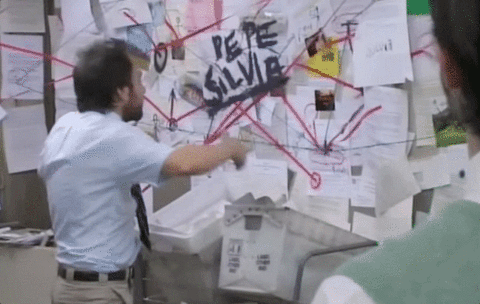
How some of this might feel
Many corporate L&D teams are slow to evolve their philosophies.
The world's getting psyched about AI, but 90% of L&D functions still use e-learning as their revolutionary delivery method.
We're in the middle of a transformation that could make or break what we know as the L&D function.
This means we have to rewire not only what we do, but how we do it. That'll lead to a new look for our local L&D teams. One shaped around providing the best service to your workforce (aka your customers).
Perhaps, the first question should be if we even call it an L&D team anymore?
But I’ll leave that debate for another day.
1/ Define the Goals of a high-performing learning team
We start with our 'why'.
Why are we doing all this, and what for? Deep stuff, I know, but we need this clarity before we can continue.
Let's keep this simple. My take is:
Enable performance and build organisational capability
Provide return on investment to the business
Support the organisational strategy with the right skills at the right time
The ultimate goal of any workplace learning function is to enable and support people in performing at work.
We serve our audience by improving their performance.
They feel good. We feel good, and the company feels good. Plus, better performance should = more business revenue and access to improved career opportunities.
But...for the business...
Corporate L&D is about making an impact on the bottom line. There is no getting away from that. No matter how much it sucks to say.
And that can be achieved by focusing on performance.
2/ Explore the tasks and skills your L&D team needs
Before we explore roles, you need to get clear on the tasks your team does and the skills needed to do these.
To get clear on the tasks and skills you need, try out this exercise.
Tasks vs Skills assessment
Create a table like the one below.
Spend time with your team to analyse the tasks they do today and cross-reference this with the skills the team needs to do these.

Use this data to shape how and what your team delivers.
If you have no clue where to start, fret not. I have a wealth of industry data to help you get clarity on the skills side.
The modern L&D professionals must-have skills
Here's what we see from industry analysts in 2025.
1/ Redthread Research
First up is Redthread Research with their Future-proofing L&D: Developing the Right Skills report.
They asked 400 L&D pros: What skills will L&D functions need in the future? Their comments were grouped into 30 skills across the 6 skill categories you see below.
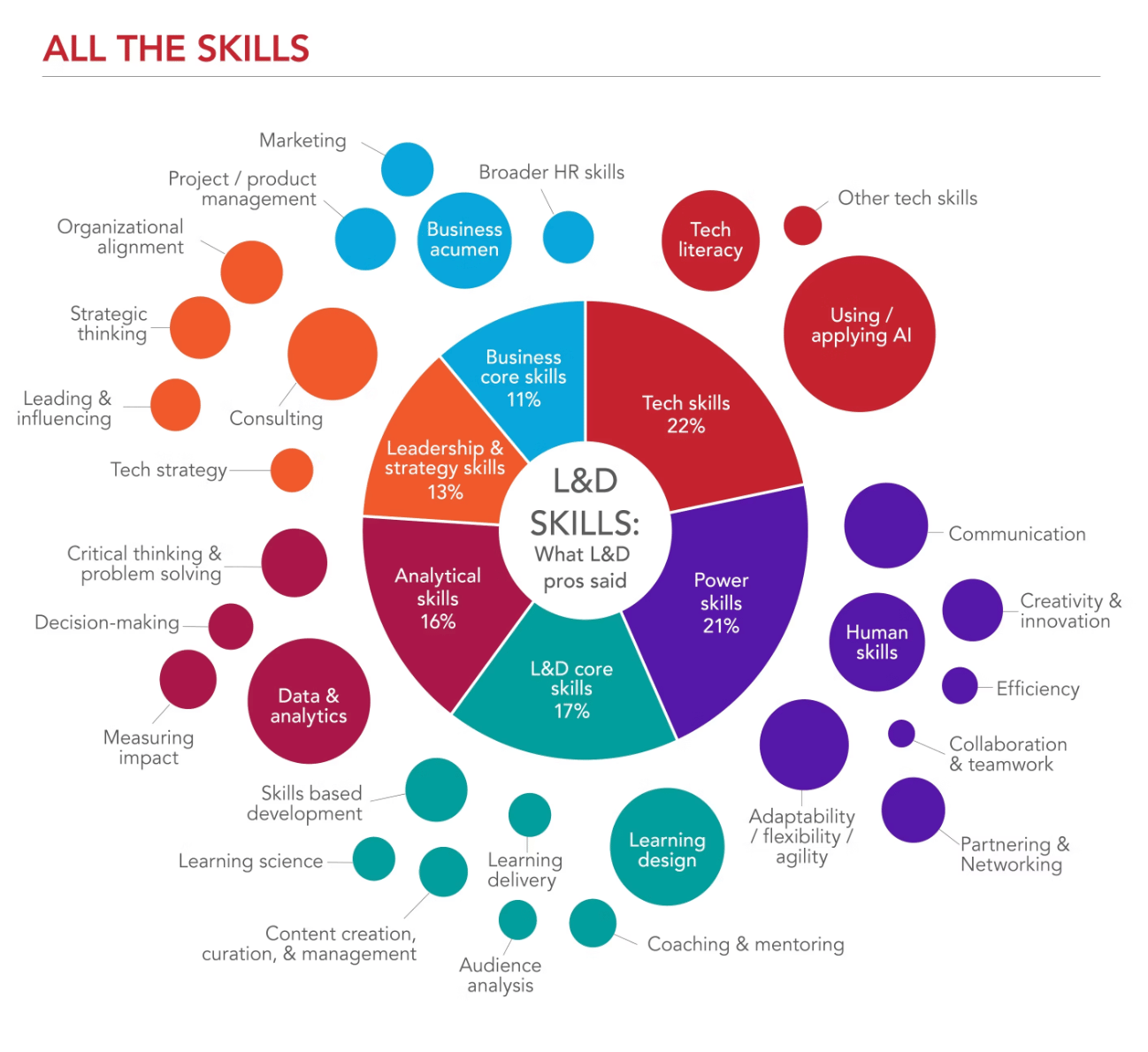
Source: Redthread Research
They revealed the 5 main skills L&D teams self-identified as:
Using and applying AI
Data and analysis
Learning design
Tech literacy (or what I call Digital Intelligence)
Human skills
2/ The Josh Bersin Company
In addition, HR research analyst, Josh Bersin, offers this perspective on the evolution of L&D teams’ role up to the modern day.
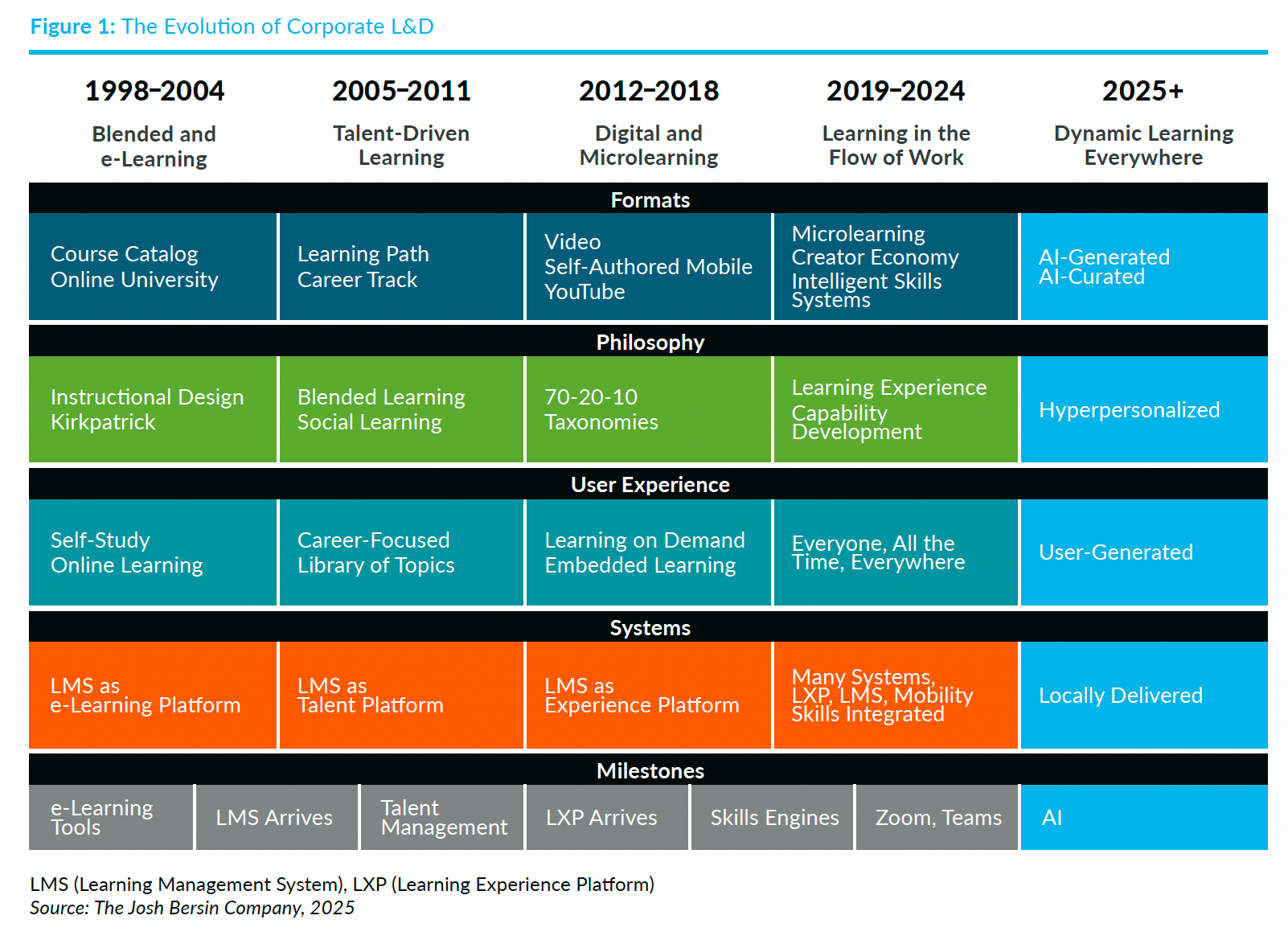
Source: It's Time For an AI Revolution Report 2025 | Bersin
3/ The Learning and Performance Institute
Then we have this collection of 30 skills that the Learning and Performance Institute positions as a marker of need for teams.
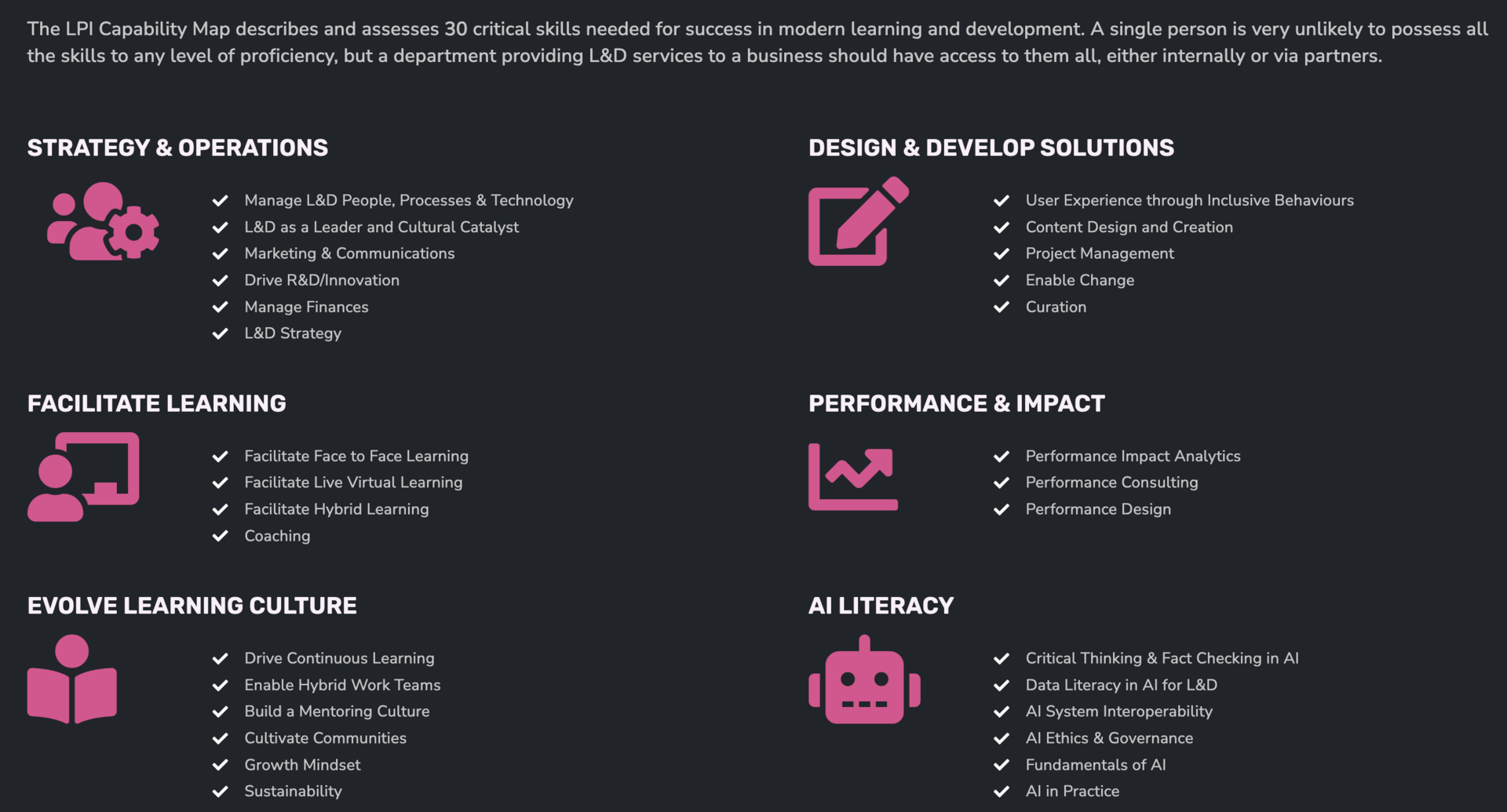
Source: LPI Capability Map
Where RedThread, Bersin and the LPI have a far more polished corporate approach.
I couldn't round up this section without including my analysis, which is more minimalistic in its tone.
Every year, I review and distil the latest industry data to identify the 7 essential skills for modern L&D pros. I use data points from industry bodies and research houses (like the above), plus I map this to data that the 5,000+ readers of my weekly newsletter share with me through annual surveys.
These, coupled with my direct work with organisation's gives me a constant view of 'what is actually needed' for L&D teams to survive and thrive.
The image below shows the focus for 2024.
Fret not, the 2025 edition is coming in a few months 👀.

Despite what you read in this section, context is king.
Your org, its culture and business goals will vary. So you need the skills that support this environment.
No matter where you land, I hope we can all agree that the modern L&D team should focus on performance instead of pushing education.
3/ How to identify the most critical roles for your L&D team
Now this, my friend, is much harder to align on in 2025.
I wrote the first edition of this guide in 2018. The only decent tool to surface content back then was Google, yet the times have changed.
We both see how all forms of artificial intelligence are reshaping how we work.
Although tasks and skills can be identified.
Who (or what) actually delivers on the tasks is not so clear-cut anymore. We’re using LLMs and AI assistants to support us with many tasks in a collaborative approach, while AI agents are quickly coming into the discussion as “do it for me” solutions.
Now, identifying who does what is going to come down to:
What can only a human do well to the level required
What can a human and AI do well together
Where is AI more efficient than a human
This is not set in stone as a framework.
It’s how I’m currently assessing roles that could exist in an L&D team in 2025, and I do expect that they will not all be done by a human.
What could L&D look like in 2027?
2027 is an arbitrary number, yet I don’t like to look too far into the future.
To help frame how we can think about a modern L&D team, let’s look at the makeup of workplace teams at large with the help of Microsoft.

Microsoft Work Trend Index Report 2025
I think we’ll see a mix of these over the years.
Probably not a linear progression, especially how tech moves so fast.
Taking all this into account, this is my bet on roles within the L&D team. They could be fulfilled by a human, a human with AI or just AI.
The answer all depends on the tech, tasks and the context of what you do.
And yes, you might lead a team of AI and humans, too.
Bonus: Get a 3-minute overview of that Microsoft research
The anatomy of a modern L&D function
Let’s unpack what modern learning and development could be.
While this section would historically be classified as “roles”, I think of them more as categories where several roles can exist. Maybe we should treat them as mini-departments.
Note that as we’re reshaping what an L&D function looks like in a world of AI, this will not include many traditional roles that are currently accepted as the standard.
Our goal is not to bolt on AI to the existing model.
We’re transforming!
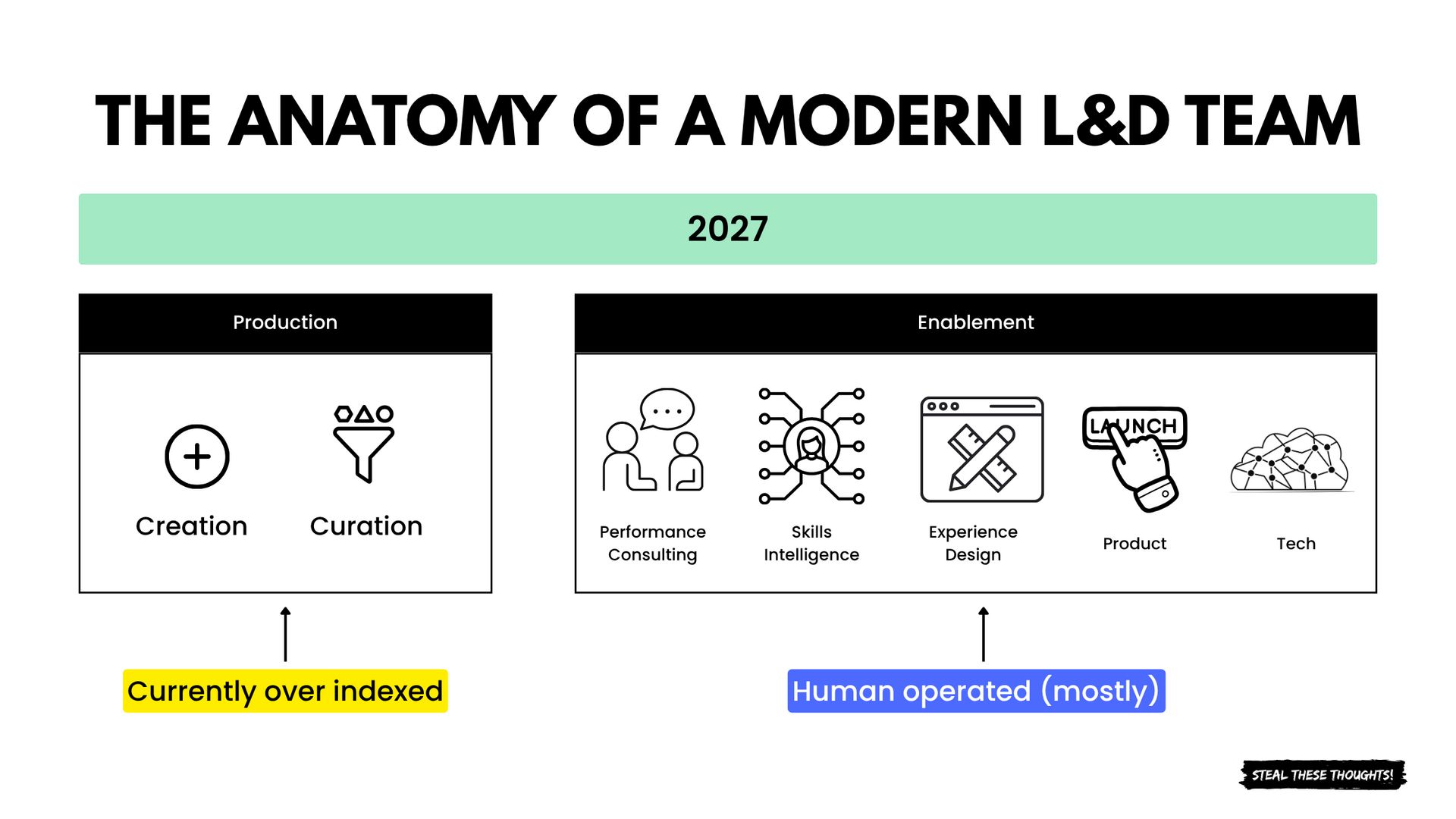
I get that this is very anti-traditional.
While today the function focuses too much on creation, I don’t think that will be the case as we look beyond 2027. Our industry is always slow to adapt, yet in those years from now, I believe we’ll have figured out how to operate creation and curation with AI, mostly.
That’s not to say human oversight won’t be needed, because it will.
But I don’t see as many design or creator roles on the scene when 1-2 people, powered with the right tools, can do the work of a much larger team.
We’re production-focused today, yet I see that balance swinging to the more meaningful side of enablement in the long term.
This isn’t about bolting on AI but rather redesigning what you deliver, and performance enablement is the more human-centred approach to workplace learning (or whatever we call it in 2027).
3 powerful modern L&D roles to invest in
Let’s pretend you put a gun to my head and demand an answer to “what are the most impactful roles?”
These would be my answers
1/ The Learning Strategist
A slight bias to this title as it’s the one I’ve given myself in my business.
When you run the show, you can do crazy stuff like this. Anyway, the strategist function is what it says on the tin, it helps define and refine the strategy for the L&D department.
It’s too easy for L&D teams to wander around doing anything and everything, while pretending it’s ‘all part of the plan’, only to have nothing to show for it at all come year’s end.
That’s why you need this role.
It may not be one person, but it needs to exist.
Your strategist will:
Define the team’s performance and capability strategy (with some sort of CLO)
Determine what needs to be done, why and define the return on investment
Direct your team throughout the year to focus on the right things, not more things, to achieve the shared strategy.
This is the core of the role, and you can make it as big or as small as you’d like.
2/ The Learning Experience Architect
These aren’t instructional designers, and they won’t focus on building stuff in authoring tools.
Learning Experience Architects (LXA’s) focus on building the right experiences to solve real problems. Forget about creating paint by number experiences.
These people will be front-facing into the business, so they’ll be focused on performance consulting to design and deliver both digital and physical experiences across the organisation (with and without AI).
Your Learning Experience Architect will:
Build strong relationships, trust and bring credibility to the L&D team’s work
Map out the real problems with stakeholders to design and deploy the best solution (and maybe that’s not an L&D one)
Develop the philosophy and design architecture for performance
Lead human experiences across physical and digital spaces
L&D is still a business of people.
No matter how much AI integrates across our workflow, people still buy from people, and your LXA’s will be a key part in influencing behaviour change.
3/ Product Manager/ Tech Architect
Naming conventions aside, you can’t have an L&D function without a dedicated focus on technology.
To do that well, you need people who have no clue about learning design, methodologies and all that noise, yet they can work with those who do to craft the best tech stack.
This role spearheads the technology stack that supports both your team and performance across the business.
Your Product Manager/Tech Architect will:
Research, test and identify the most useful technology for company performance initiatives
Craft the user experience and interface of all L&D technology across your organisation
Support for the design and deployment of in-house and external tools
Advise the L&D team on tools and infrastructure to support all team performance projects
4 shared skills every L&D team needs to have
I know the world likes to put people in boxes, but I’m not a fan of that.
Your L&D team will be full of specialists and generalists, yet they do need a shared language of skills across the function.
Let’s focus on some of the core shared skills needed:
🤖 AI Fluency
As I update this post in 2025, the last 3 years have been dominated by one word: “AI”.
We say ‘AI’, but what we mean is generative AI, which has kicked off this wider AI arms race. AI itself has been around a long time, yet generative AI, deployed in particular through Large Language Models like ChatGPT, has sparked mass attention across the space.
It would be foolish of me not to recognise this impact and how the skill of intelligently leveraging it is a must, no matter your industry.
AI in itself is not a skill, but knowing how to use it is.
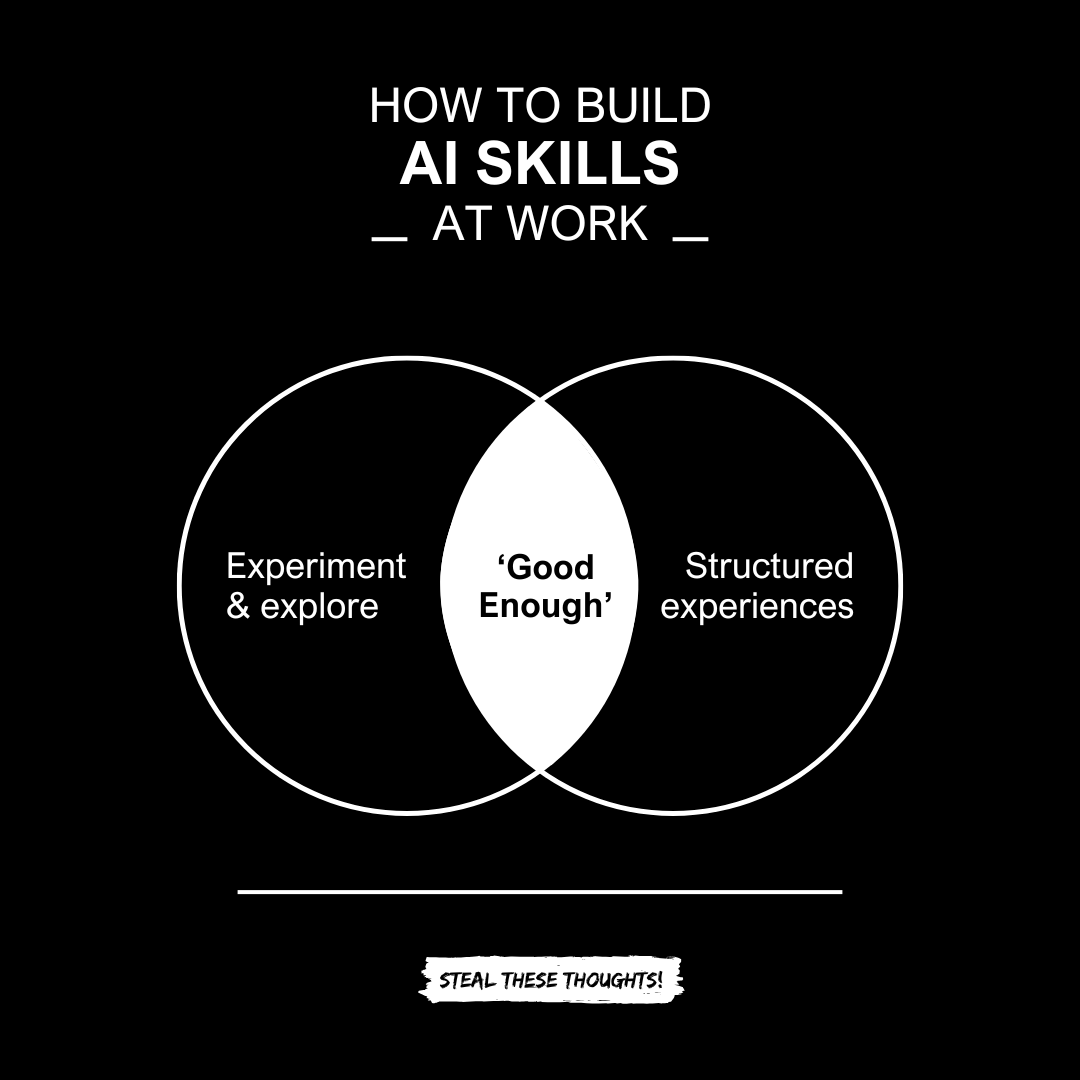
The term “AI Literacy” has been thrown around to describe the collection of skills and behaviours humans need to expertly leverage tools in this category. I’ve recently come to appreciate the term “AI Fluency”, introduced by the Anthropic team, instead.
It sounds less education-ish, in my opinion.
No matter what you call it, we all need it.
AI Fluency looks like this:
Foundational understanding of how AI works (all types, not just generative)
The ability to determine when AI could be a useful part of a solution, and with this, when it should be used and where.
The capability to collaborate with AI tools to deliver an outcome (the how).
Understanding the opportunities and limitations of AI systems from a technical and ethical perspective
Fluency with AI doesn’t focus on the ‘how’ alone, it’s an ecosystem of skills, behaviours and thinking about thinking (aka metacognition).
Back when I worked in a team, I was always the ‘tech’ guy.
Everyone would come to me with anything related to tech. That can’t happen with AI, it never should have with tech in general. It’s everyone’s shared responsibility to know how to use AI intelligently.
Plus, it’s a must have set of skills and behaviours for the modern day workplace.
It seems we’ll all need to be AI-native.
Resources:
📣 Storytelling (inc marketing and sales)
I’m cheating here a bit because I’m grouping a few categories under one banner.
We’re in the business of people, which means we must be able to connect with them and influence them through change.
That means you have to be a good storyteller.
People don’t change for no reason, and I’m a big believer that good stories entertain people, but great stories change people.
Marketing and sales are both forms of storytelling as they serve the purpose of telling the stories of your work, people and the results.
What I’m not saying is you need to learn to be an expert marketer and salesman, but you’d be wise to understand a few techniques.
Our industry falls too often into the trap of build and they will come.
You can have the most amazing learning content in human existence, but if no one knows it exists, what it does and why it’s important for them, you’re pretty much digging your own grave.
You need the whole team to buy into this way of thinking.
It’s something we each do every day, in many ways.
You market/sell your skills to a potential employer, you market ideas to business leaders, and you even use marketing techniques to convince your crush to go on a date with you.
Resources:
🤝 Performance consulting
Think of Performance Consulting as being the workplace detective of the L&D world.
It’s not just about throwing a training program at a problem and hoping it sticks (or not spraying and praying as I was once told).
Nope. You dig deeper.
You chat with the team, look at the data, and figure out what’s really happening. Then, you come up with a game plan that might be training, but could also be other stuff like better tools, process changes, or even a simple conversation.
The end game is making sure everyone performs better and the business scores a win.
The art of consulting seems lost in L&D teams.
We take a lot of questions, but ask few questions. Sometimes, you have to do this. The nature of your organisation can be tough to change.
Your mission is to partner with the workforce to understand their needs and propose the best solution. That might not even be an L&D solution 😨.
Resources:
Unpack why performance consulting is so important for the modern L&D pro here.
Craft your skills in this area with The Art of Performance Consulting Masterclass for L&D Teams
🖥️ Digital Intelligence
We’re biological beings living in an increasingly digital world.
This skill isn’t exclusive to our industry. It’s a must for every human.
I’ve spent too much of my career watching people shy away from tech. You cannot do that anymore. I hate to sound like one of those morons on social media who say, “Do this or be left behind”. But I’m going to make an exception here.
If you don’t invest in your digital intelligence, you will be left behind.
Defining Digital Intelligence
Let’s keep this simple.
It’s about being savvy, aware and adaptable with new digital technologies. You don’t need to be an expert but you must be aware of what’s available. Be curious, always.
Our world needs more digital-savvy pros.
As the world of learning continues to be eaten up by tech. You would be wise to become fluent in the language of technology to become a valued strategic business partner.
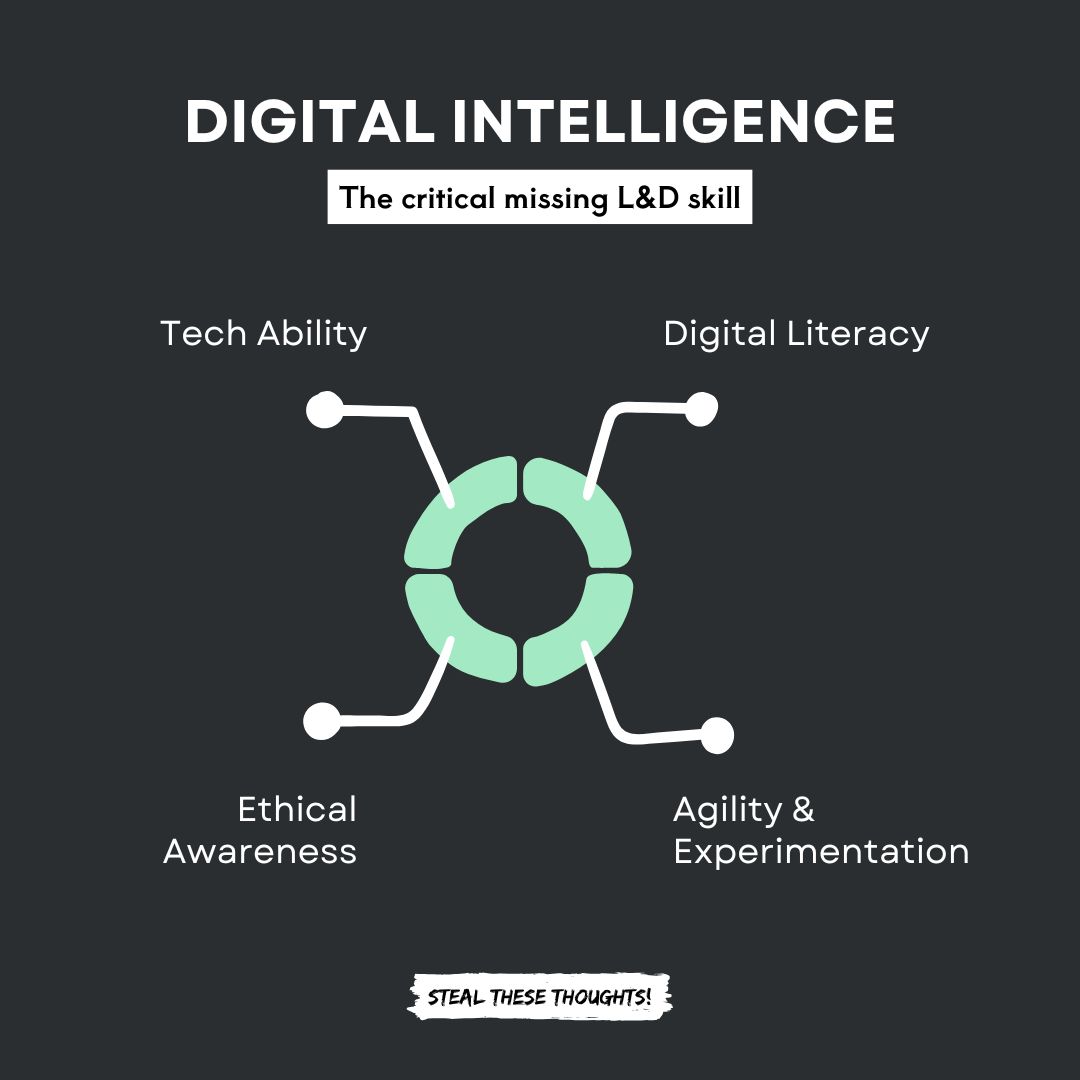
Even outside of L&D, a basic level of understanding of how different technologies work, connect and support one another is essential.
Not every member of your team needs to be an expert in this field, but they should have a shared understanding.
Again, some of you reading this might be resistant and suggest that a technology team should do this.
Your team will know the application for any learning tech better than anyone. They will understand how it works in practice, so keeping up to date with modern technology will always be an enhancer
This knowledge will separate your team from the industry.
If you keep up with trends, absorb what is useful, avoid what is not and apply what works for your audience. You will create a high-performing learning function.
The L&D leader
You may know it as the Head of Learning, Director of Learning, Chief Learning Officer or whatever flavour of the month title is today.
Maybe this is you right now, or it’s one of your aspirations.
Nonetheless, let’s unpack what it means to be an L&D leader in the modern era.
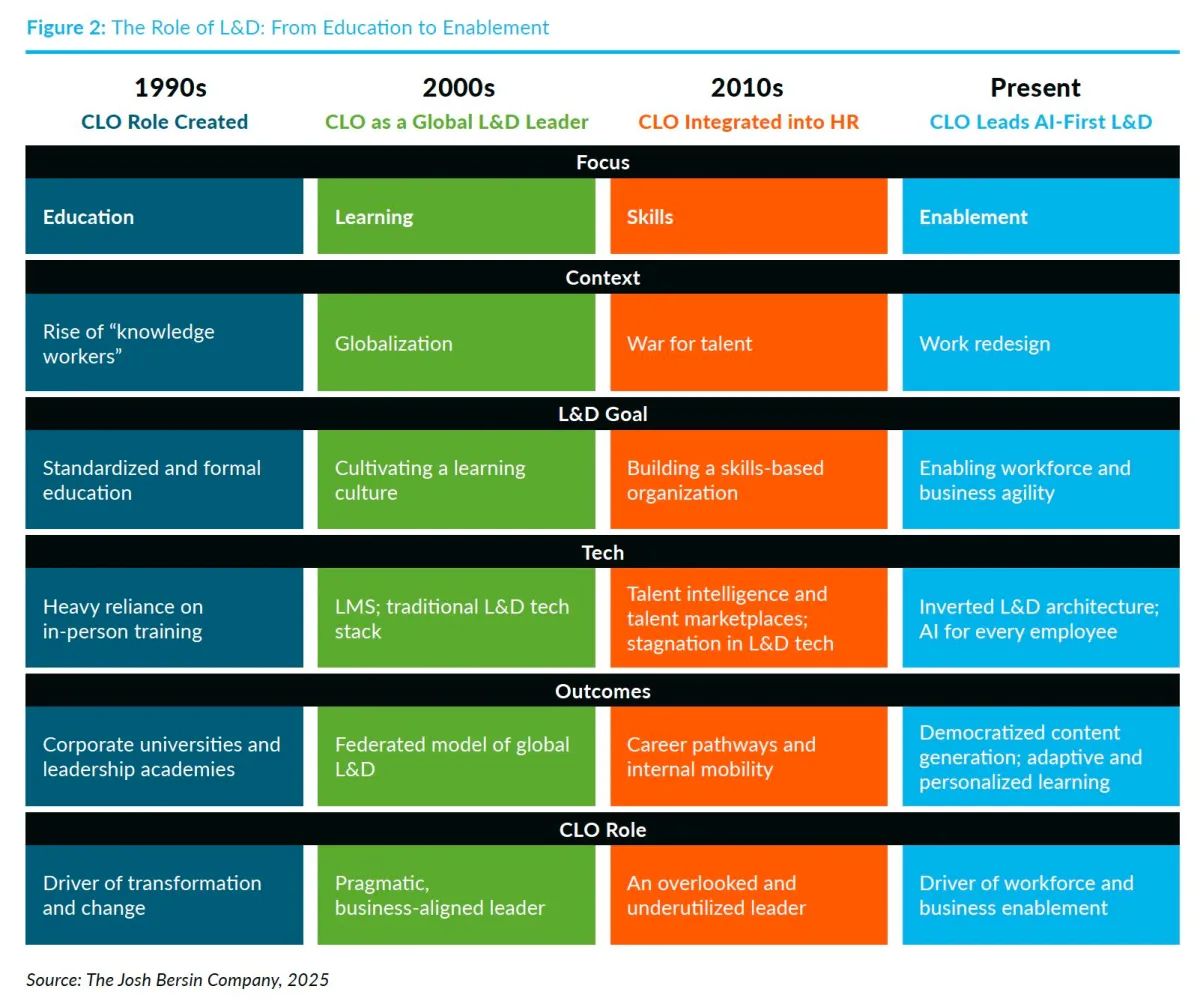
What does a L&D leader do?
The learning leadership role for me is one of a strategist, coach and enabler.
What I learnt quite quickly when heading up a department myself is that 80% of my tasks move to nurturing people.
I still got involved in projects from a strategic standpoint, but doing the actual project build wasn’t part of the gig. This was difficult to get my head around at first.
You’re now in charge of the compass and the map, plus your crew of L&D pros.
That doesn’t mean you stop learning.
Like your team, you will be on top of evolving trends, insights and practices which allow you to nurture a clear vision for the team to work towards.
You enable your people to do what they need to.
A modern learning leader should provide the freedom to experiment, propose new ideas, test stuff and ultimately innovate the way you work.
Of course, context, culture and organisational constraints play a big part in what you can achieve. So don’t be too hard on yourself about this.
This will evolve
As I said from the get-go, this is just how I would build a team today.
These will evolve as the world changes and the dynamics of the workplace with it. So, don’t take what I’ve shared as set in stone.
I’m sure a year from now my recommendation could look different.
Instead, use these as the foundational building blocks to the function you want to shape.
Final thoughts
There is no “one way” to do this.
It is very much a ‘choose your own adventure’ style journey based on how you want to shape the future of your team as we reshape work with AI.
Here’s a final exercise to help you…
When you look at your L&D team today, ask yourself:
Are they providing the service your audience needs?
If not, why not?
Has your team been set up to deliver the service your workplace requires?
→ If you’ve found this helpful, please consider sharing it wherever you hang out online, tag me in and share your thoughts.
Till next time, you stay classy, learning friend!
PS… If you’re enjoying the newsletter, will you take 4 seconds to forward this edition to a friend? It goes a long way in helping me grow the newsletter (and cut through our industry BS with actionable insights).
And one more thing, I’d love your input on how to make the newsletter even more useful for you!
So please leave a comment with:
Ideas you’d like covered in future editions
Your biggest takeaway from this edition
I read & reply to every single one of them!

VIDEO THOUGHTS 💾
How To Make Your AI Adoption Projects Actually Succeed
Most organisations are racing to plug generative AI into learning & development, but according to global research, 4 out of 5 AI projects still crash and burn.
Failure is not a bad thing because it uncovers what not to do.
So I put this video together with a patchwork of research I've found useful and experiences with organisations to map the findings from project failures to everyday L&D realities.
I'm pretty confident that a lot of this might strike a chord with you.
I unpack where teams go wrong, how to avoid “shiny-tool syndrome,” and what it really takes to turn AI into measurable impact (imo).
Enjoy and do share your thoughts with me.
🙋♀️ Want to reach over 5,000 L&D pros? Become a Newsletter sponsor in 2025
P.S. Wanna build your L&D advantage?
Here’s a few ways I can help:
Build your confidence and skills with the only AI course designed for L&D pros.
Become a better L&D partner with the Art of Performance Consulting.
Get a backstage pass to exclusive industry insights, events and a secret monthly newsletter with a premium membership.
Book a 1:1 consulting session with me for support with your product or L&D tech challenges
Hire me to talk at your company


Reply